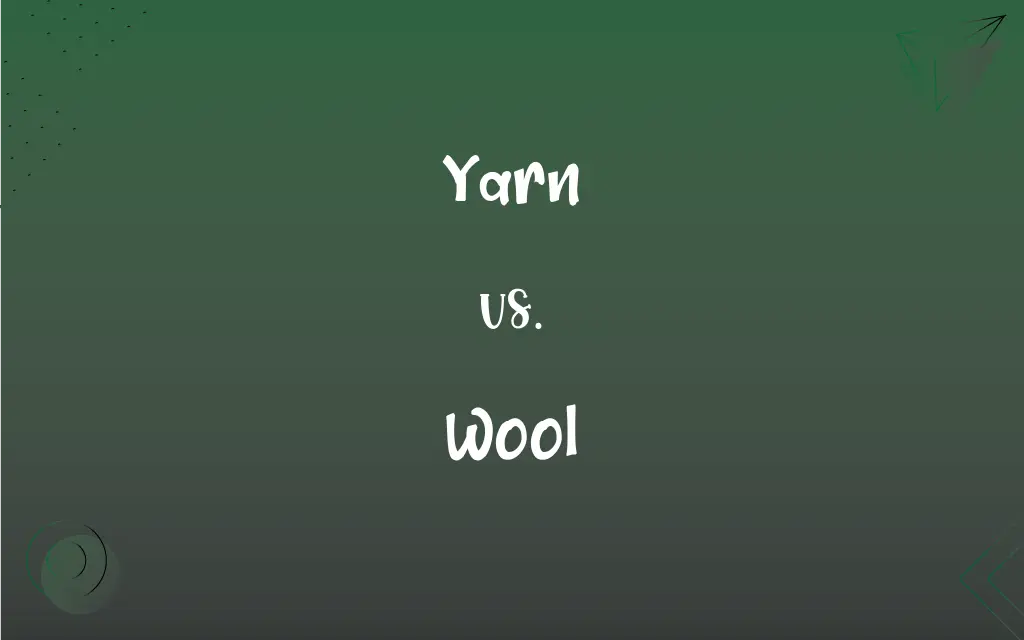Yarn vs. Wool: What's the Difference?
Edited by Aimie Carlson || By Harlon Moss || Published on December 21, 2023
Yarn is a long, continuous length of interlocked fibers used for knitting or weaving; wool is a natural fiber obtained from sheep and other animals.

Key Differences
Yarn is a generic term for a continuous strand of textile fibers, used in knitting, weaving, and crocheting. Wool, specifically, is a type of yarn made from the fleece of sheep or other animals.
Yarn can be made from various materials, including wool, cotton, acrylic, and silk. Wool refers exclusively to the soft, curly fibers obtained from the fleece of animals like sheep.
The properties of yarn depend on its material, which could be wool or synthetic fibers. Wool is known for its warmth, breathability, and natural insulation properties.
Yarns vary in thickness, texture, and strength, based on their material and manufacturing process. Wool, as a material for yarn, offers elasticity and is often preferred for winter garments.
Yarn is used in a broad range of textile products, from clothing to home furnishings. Wool, due to its specific qualities, is particularly valued in the production of warm clothing and blankets.
ADVERTISEMENT
Comparison Chart
Material Composition
Made from various materials
Specifically made from animal fleece
Properties
Varies depending on material
Warm, breathable, insulating
Uses
Broad, including textiles and furnishings
Primarily for warm clothing and blankets
Types
Can be natural or synthetic
Always natural
Texture and Strength
Depends on material and process
Characteristically elastic and strong
ADVERTISEMENT
Yarn and Wool Definitions
Yarn
A continuous length of interlocked fibers.
The yarn was soft and perfect for a baby blanket.
Wool
Soft, curly fibers obtained from sheep.
The wool sweater was incredibly warm.
Yarn
Twisted strands of fiber used for knitting or weaving.
She bought colorful yarn for her knitting project.
Wool
A natural fiber used for making yarn.
She preferred using wool for her winter knits.
Yarn
Material used in textile and craft projects.
He used yarn to create a handmade scarf.
Wool
Animal fleece used in textile production.
The wool from that region is known for its quality.
Yarn
A fiber strand used in making fabrics or textiles.
The yarn was spun from high-quality cotton.
Wool
A material known for its insulation properties.
Woolen garments are essential for cold climates.
Yarn
A term for the raw material in knitting and weaving.
She chose a durable yarn for her crochet work.
Wool
Fiber from sheep used in clothing and blankets.
The wool blanket provided much-needed warmth.
Yarn
A continuous strand of twisted threads of natural or synthetic fibers, such as wool or nylon, used in weaving or knitting.
Wool
The dense, soft, often curly hair forming the coat of sheep and certain other mammals, such as the goat and alpaca, consisting of cylindrical strands of keratin covered by minute overlapping scales and much valued as a textile fiber.
Yarn
A similar strand of other materials such as glass or plastic.
Wool
Fabric or yarn made of this hair.
FAQs
Can yarn be made of wool?
Yes, yarn can be made from wool, among other materials.
Is all yarn made from wool?
No, yarn can be made from various materials, not just wool.
What is yarn?
Yarn is a long, continuous length of interlocked fibers used in textiles.
What is wool?
Wool is a natural fiber from the fleece of sheep or other animals.
What are the characteristics of wool?
Wool is warm, breathable, and has natural insulating properties.
What makes wool unique compared to other yarns?
Wool's natural warmth, elasticity, and breathability make it unique.
Are there different types of wool?
Yes, there are various types, like Merino, Cashmere, and Alpaca wool.
Can wool be synthetic?
No, wool is a natural fiber; synthetic alternatives try to mimic its properties.
Is wool hypoallergenic?
Wool is not hypoallergenic and can cause allergies in some people.
How is yarn produced?
Yarn is produced by spinning fibers together, whether natural or synthetic.
How do you care for wool garments?
Wool garments require gentle washing and proper storage to avoid damage.
What is the difference in durability between yarn and wool?
Durability varies based on the type of yarn; wool is generally durable but requires careful maintenance.
What are the uses of yarn?
Yarn is used in knitting, weaving, crocheting, and making textiles.
Is wool suitable for all types of garments?
Wool is particularly suited for warm garments but may not be ideal for all types.
Is all yarn suitable for knitting?
Most yarns are suitable for knitting, but the choice depends on the project.
Can wool be blended with other fibers?
Yes, wool is often blended with other fibers for different textures and properties.
Can wool be dyed?
Yes, wool can be dyed in various colors.
Is wool more expensive than other yarns?
Wool can be more expensive than some synthetic yarns due to its natural origin.
What are the environmental impacts of wool production?
Wool production has environmental impacts, including land and water use, but it is a renewable resource.
Can yarn be used for home furnishings?
Yes, yarn is widely used in home furnishings like blankets and rugs.
About Author
Written by
Harlon MossHarlon is a seasoned quality moderator and accomplished content writer for Difference Wiki. An alumnus of the prestigious University of California, he earned his degree in Computer Science. Leveraging his academic background, Harlon brings a meticulous and informed perspective to his work, ensuring content accuracy and excellence.
Edited by
Aimie CarlsonAimie Carlson, holding a master's degree in English literature, is a fervent English language enthusiast. She lends her writing talents to Difference Wiki, a prominent website that specializes in comparisons, offering readers insightful analyses that both captivate and inform.































































